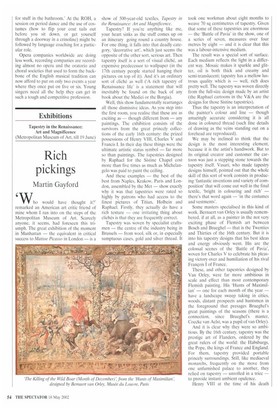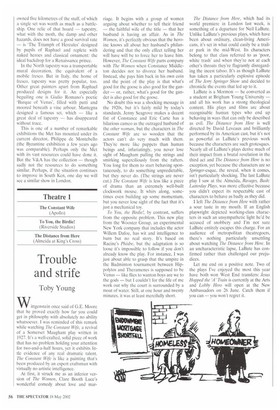Rich pickings
Martin Gayford
Who would have thought it?' remarked an American art critic friend of mine whom I ran into on the steps of the Metropolitan Museum of Art. Scarcely anyone, it seems, had foreseen this triumph. The great exhibition of the moment in Manhattan — the equivalent in critical success to Matisse Picasso in London — is a
show of 500-year-old textiles, Tapestry in the Renaissance: Art and Magnificence.
Tapestry? If you're anything like me, your heart sinks as the stuff comes up on an itinerary going round a country house. For one thing, it falls into that deadly category, 'decorative art', which just seems the opposite of the other sort, serious art. Then tapestry itself is a sort of visual cliché, an expensive predecessor to wallpaper (in the 17th century people started hanging their pictures on top of it). And it's an ordinary sort of cliché as well ('A rich tapestry of Renaissance life' is a statement that will inevitably be found on the back of any book about the Medici or the Borgia).
Well, this show fundamentally rearranges all those dismissive ideas. As you step into the first room, you realise that these are as exciting as — though different from — any paintings. The exhibition consists of the survivors from the great princely collections of the early 16th century: the prized possessions of Henry VIII, Charles V and Francis I. In their day these things were the ultimate artistic status symbol — far more so than paintings. The tapestries designed by Raphael for the Sistine Chapel cost more than five times as much as Michelangelo was paid to paint the ceiling.
And these examples — the best of the best from Naples, Krakow, Paris and London, assembled by the Met — show exactly why it was that tapestries were rated so highly by patrons who had access to the finest pictures of Titian, Holbein and Raphael. Firstly, they actually do have a rich texture — one irritating thing about clichés is that they are frequently correct.
Tapestry was woven by specialist craftsmen — the centre of the industry being in Brussels — from wool, silk or, in especially sumptuous cases, gold and silver thread. It
took one workman about eight months to weave 70 sq centimetres of tapestry. Given that some of these tapestries are enormous — the 'Battle of Pavia' in the show, one of a series of seven, measures over four metres by eight — and it is clear that this was a labour-intensive medium.
The result was a special sort of surface. Each medium reflects the light in a different way. Mosaic makes it sparkle and glitter, oil is both thick and creamy and semi-translucent; tapestry has a mellow lustrous quality which is — well, rich does pretty well. The tapestry was woven directly from the full-size design made by an artist (the Raphael cartoons in the V&A are the designs for those Sistine tapestries).
Thus the tapestry is an interpretation of the painter's colour and line — though amazingly accurate considering it is all done in coloured thread (such fine details of drawing as the veins standing out on a forehead are reproduced).
We may be inclined to think that the design is the most interesting element, because it is the artist's handiwork. But to its original creator and customer the cartoon was just a stepping stone towards the tapestry itself. Vasari, who made tapestry designs himself, pointed out that the whole skill of this sort of work consists in producing 'fantastic inventions and variety of composition' that will come out well in the final textile, 'bright in colouring and rich' — there's that word again — 'in the costumes and vestments'.
Some masters specialised in this kind of work. Bernaert van Orley is usually remembered, if at all, as a painter in the not very exciting phase of Flemish art between Bosch and Brueghel — that is the Twenties and Thirties of the 16th century. But it is into his tapestry designs that his best ideas and energy obviously went. His are the colossal scenes of the 'Battle of Pavia', woven for Charles V to celebrate his pleasing victory over and humiliation of his rival Francois I of France.
These, and other tapestries designed by Van Orley, were far more ambitious in scale and effect than most contemporary Flemish painting. His 'Hunts of Maximilian' — one for each month of the year — have a landscape sweep taking in cities, woods, distant prospects and huntsmen in the foreground that presages Brueghel's great paintings of the seasons (there is a connection, since Bnteghel's master, Coecke van Aelst, was a pupil of van Orley).
And it is clear why they were so ambitious. By the 16th century, tapestry was the prestige art of Flanders, ordered by the great rulers of the world: the Habsburgs, the Pope, the kings of France and England. For them, tapestry provided portable princely surroundings. Still, like mediaeval monarchs, frequently on the move from one unfurnished palace to another, they relied on tapestry — unrolled in a trice — to provide instant ambient opulence.
Henry VIII at the time of his death owned five kilometres of the stuff, of which a single set was worth as much as a battleship. One relic of that hoard — tapestry, what with the moth, the damp and other hazards, does not have a good survival rate — is 'The Triumph of Hercules' designed by pupils of Raphael and replete with naked heroes and classical ornament: the ideal backdrop for a Renaissance prince.
In the North tapestry was a transportable mural decoration, the equivalent of a mobile fresco. But in Italy, the home of fresco, tapestry was pretty popular, too. Other great painters apart from Raphael produced designs for it. An especially beguiling one is Giulio Romano's poetic 'Barque of Venus', filled with putti and moored beneath a vine arbour. Mantegna designed a famous set, which — like a great deal of tapestry — has disappeared without trace.
This is one of a number of remarkable exhibitions the Met has mounted under its current director, Philippe de Montebello (the Byzantine exhibition a few years ago was comparable). Perhaps only the Met with its vast resources could have done it. But the V&A has the collection — though sadly not the resources to do something similar. Perhaps, if the situation continues to improve in South Ken, one day we will see a similar show in London.















































































 Previous page
Previous page